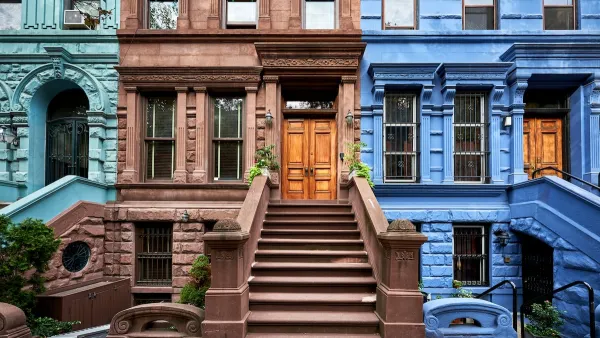An inexpensive architectural style is deemed unfit for a town looking to preserve its history—and become a more sophisticated city.
Supposedly "[a]larmed by a map of demolitions the City Council was to review, "Jersey City Mayor Steve Fulop has imposed a six-month moratorium on the issuing of new demolition permits for "structurally sound" one-to-four unit buildings.
The Jersey Journal reports that the order has "ignited a battle between his administration and local developers," but that "Fulop says he's siding with Heights residents who accuse developers of building homes that destroy the character of neighborhoods."/p>
Or as Fulop put it succinctly in a Twitter post, "We're losing many of our great/old homes + being replaced w/the architectural marvel known as 'The Bayonne Box.'"
The "Bayonne Box" is a vernacular architectural style that dates to the 1990s; it's typically characterized by three stories, usually more than one unit, and a curb cut to facilitate off-street parking.
The boxes were developed as a way to quickly produce inexpensive housing that appealed to those living in it (and still do—one supporter of Fulop's moratorium is the president of a neighborhood association who admits to living in one and liking it) but are inconsistent with a place that is now trying to increase density and discourage car ownership though better transit; Newark made similar efforts a decade ago.
In the next six months, Jersey City plans to review the ordinances that govern preservation and development; currently, for example, a builder cannot cut the curb for an old structure, but can do so if they tear it down and build a new one.
Part of the problem for those opposing Fulop's order is that, like much of the nation, New Jersey has an affordable housing problem, but given its proximity to Manhattan, no shortage of new luxury high-rise apartment buildings. Not many people care to defend to the aesthetic appeal of the Bayonne Box, but a few recognize its continuing appeal.
FULL STORY: Fulop demolition ban targets 'Bayonne boxes' in Jersey City

Planetizen Federal Action Tracker
A weekly monitor of how Trump’s orders and actions are impacting planners and planning in America.

Maui's Vacation Rental Debate Turns Ugly
Verbal attacks, misinformation campaigns and fistfights plague a high-stakes debate to convert thousands of vacation rentals into long-term housing.

Restaurant Patios Were a Pandemic Win — Why Were They so Hard to Keep?
Social distancing requirements and changes in travel patterns prompted cities to pilot new uses for street and sidewalk space. Then it got complicated.

In California Battle of Housing vs. Environment, Housing Just Won
A new state law significantly limits the power of CEQA, an environmental review law that served as a powerful tool for blocking new development.

Boulder Eliminates Parking Minimums Citywide
Officials estimate the cost of building a single underground parking space at up to $100,000.

Orange County, Florida Adopts Largest US “Sprawl Repair” Code
The ‘Orange Code’ seeks to rectify decades of sprawl-inducing, car-oriented development.
Urban Design for Planners 1: Software Tools
This six-course series explores essential urban design concepts using open source software and equips planners with the tools they need to participate fully in the urban design process.
Planning for Universal Design
Learn the tools for implementing Universal Design in planning regulations.
Heyer Gruel & Associates PA
JM Goldson LLC
Custer County Colorado
City of Camden Redevelopment Agency
City of Astoria
Transportation Research & Education Center (TREC) at Portland State University
Jefferson Parish Government
Camden Redevelopment Agency
City of Claremont





























